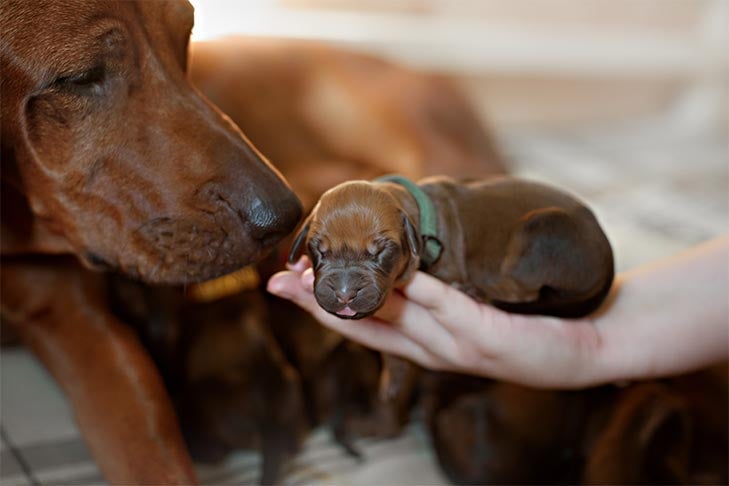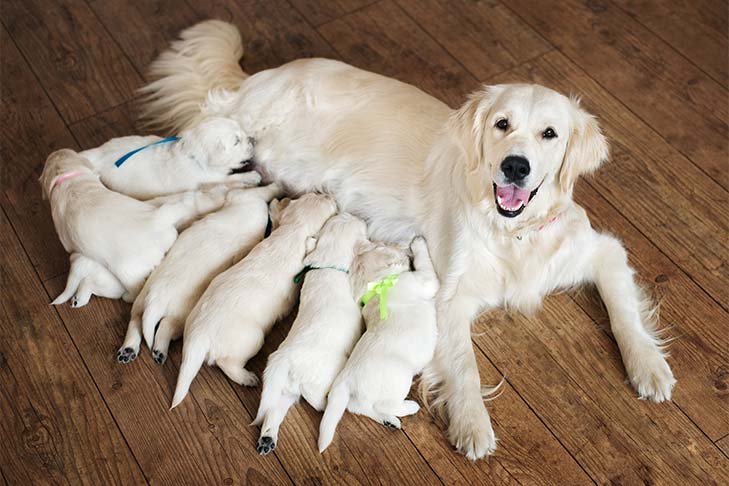Your dog wins friends and admirers everywhere she goes. She is purebred, happy, and well-groomed, and you are naturally very proud of her. Then, someone at Doggy Daycare asks you the question you can’t get out of your head: “Are you planning to breed her? I’d love a puppy!”
From that moment on, you are consumed by thoughts of sweet puppy breath, giggling children, and happy families driving off into the sunset. But surfing the internet even briefly will tell you what a huge responsibility you are considering. So what is involved in breeding a litter, if you are going to do it right? It’s time to sit down with a cup of coffee and ask yourself some sobering questions.
Why Do You Want To Breed?
In planning a litter, good breeders always endeavor to produce puppies that will be sound in body and mind. That starts with pairing two dogs that complement one another and conform to the breed standard. How does your female meet the breed standard? Every breed has a standard that describes the ideal specimen in structure, movement, and temperament.

Most of us show our dogs to see how they measure up against others of the same breed. Dog shows were initially developed to evaluate breeding stock, and that carries through to today. Winning under multiple judges to earn a championship tells us our dogs have the quality to breed and produce the next generation.
The Importance of Genetic Health Testing
Then we turn our attention to things that can’t be seen in the show ring. Are you familiar with the inherited defects that can afflict your breed? Your female will need a thorough veterinary examination to confirm that she is in good health, as well as genetic testing to ensure that she is free of any serious issues (hips, eyes, elbows, heart) that could be passed on to her offspring. The potential sire of her litter should have undergone the same rigorous health testing.
Breeding a litter can get very expensive. Besides the health testing and stud fee to be paid, there will be the cost of ongoing veterinary care and good food for Mom and babies. Depending upon the breed and the number of puppies she is carrying, a C-section may be necessary to deliver them. There will be several rounds of puppy vaccinations needed before the young ones are ready to go to their new homes at eight to 12 weeks.
Dog Breeding is a Lifelong Responsibility
Speaking of new homes, are you prepared to keep the puppies until suitable homes are found? Long-established breeders often have waiting lists of puppy buyers, but as a first-time breeder, you won’t be as well known so sales may be slow. Do you have the facilities to hang on to four, five, or six energetic, growing puppies?
Are you also ready and willing to take back a puppy or grown dog, should divorce, job loss, terminal illness, or death ever befall one of your owners? It’s what responsible breeders do, although the timing is never right.

Finding a Mentor
The ideal person to help shepherd you through these many challenges is, of course, your dog’s breeder. However, if they live on the other side of the country or on another continent, a local mentor will be invaluable. To find one, join your local breed club or attend a dog show to meet the exhibitors. We were all novices once, and breeders are generally willing to lend a hand to new people who share their passion for the breed.
Ask experienced breeders to evaluate your female against the standard, as well as suggest stud dogs whose structure and pedigree complement hers. (By that we mean not doubling up on flaws, so taking a slightly built female to a more substantial, bigger-boned male rather than an equally slight one.) These breeders may also have a few folks on their waiting list who might be the right fit for a puppy from your litter.
Another essential way to build your breeder network is to join your local all-breed kennel club. Even if there are no members who own your breed, you will meet longtime breeders who can help you deliver that first litter. It is a stressful experience that you don’t want to go through alone. You will also learn a great deal about our sport by attending regular club meetings.
Breeding a litter should never be a casual undertaking. However, the sport needs enthusiastic, passionate new breeder-exhibitors coming up through the ranks. Don’t be shy about asking for advice. Before you know it, you’ll be the one paying it forward.
Registering Your Litter
After becoming the owner of new puppies born in the U.S., it is important to register your dog. Why? The AKC is the only purebred dog registry in the United States that maintains an investigation and inspection effort. The AKC conducts thousands of inspections each year to ensure the health, safety, and welfare of dogs and the environments in which they live. Plus, dogs will need to have a registration number regardless to compete in AKC-sanctioned sports.
You can register your dog litter here.

